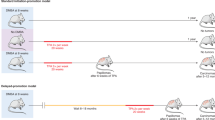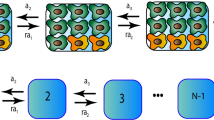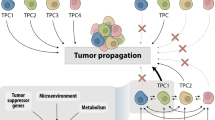Abstract
Many carcinogens are mutagens, indicating that mutagenesis is the driving force of carcinogenesis. But what if we turn this prevailing view on its head? I will argue here that carcinogens are cytostatic and/or cytotoxic, and it is not mutation per se, but clonal selection for resistance to these antiproliferative conditions, that leads to cancer. But why aren't all cytotoxins carcinogenic?
This is a preview of subscription content, access via your institution
Access options
Subscribe to this journal
Receive 12 print issues and online access
$209.00 per year
only $17.42 per issue
Buy this article
- Purchase on Springer Link
- Instant access to full article PDF
Prices may be subject to local taxes which are calculated during checkout





Similar content being viewed by others
References
Vogelstein, B. & Kinzler, K. W. The multistep nature of cancer. Trends Genet. 9, 138–141 (1993).
Hanahan, D. & Weinberg, R. A. The hallmarks of cancer. Cell 100, 57–70 (2000).
Cahill, D. P., Kinzler, K. W., Vogelstein, B. & Lengauer, C. Genetic instability and Darwinian selection in tumours. Trends Cell Biol. 9, M57–M60 (1999).
Tomlinson, I. & Bodmer, W. Selection, the mutation rate and cancer: ensuring that the tail does not wag the dog. Nature Med. 5, 11–12 (1999).
Duesberg, P., Stindl, R. & Hehlmann, R. Explaining the high mutation rates of cancer cells to drug and multidrug resistance by chromosome reassortments that are catalyzed by aneuploidy. Proc. Natl Acad. Sci. USA 97, 14295–14300 (2000).
Rissler, P., Torndal, U. B. & Eriksson, L. C. Induced drug resistance inhibits selection of initiated cells and cancer development. Carcinogenesis 18, 649–655 (1997).
Meijer, G. A. et al. Increased expression of multidrug resistance related proteins Pgp, MRP1, and LRP/MVP occurs early in colorectal carcinogenesis. J. Clin. Pathol. 52, 450–454 (1999).
Giannakakou, P. et al. Paclitaxel-resistant human ovarian cancer cells have mutant β-tubulins that exhibit impaired paclitaxel-driven polymerization. J. Biol. Chem. 272, 17118–17125 (1997).
Amarante-Mendes, G. P. et al. BCR–ABL exerts its antiapoptotic effect against diverse apoptotic stimuli through blockage of mitochondrial release of cytochrome c and activation of caspase-3. Blood 91, 1700–1705 (1998).
Hart, B. A., Potts, R. J. & Watkin, R. D. Cadmium adaptation in the lung: a double-edged sword? Toxicology 160, 65–70 (2001).
Tsujimoto, Y., Cossman, J., Jaffe, E. & Croce, C. M. Involvement of the BCL2 gene in human follicular lymphoma. Science 228, 1440–1443 (1985).
Rossiter, H. et al. Targeted expression of Bcl-2 to murine basal epidermal keratinocytes results in paradoxical retardation of ultraviolet- and chemical-induced tumorigenesis. Cancer Res. 61, 3619–3626 (2001).
Greenhalgh, D. A., Wang, X. J., Donehower, L. A. & Roop, D. R. Paradoxical tumor inhibitory effect of p53 loss in transgenic mice expressing epidermal-targeted v-Hras, v-Fos, or human transforming growth factor-α. Cancer Res. 56, 4413–4423 (1996).
Judah, D. J., Legg, R. F. & Neal, G. E. Development of resistance to cytotoxicity during aflatoxin carcinogenesis. Nature 265, 343–345 (1977).
Gabrielson, E. W. et al. Human mesothelioma cells and asbestos-exposed mesothelial cells are selectively resistant to amosite toxicity: a possible mechanism for tumor promotion by asbestos. Carcinogenesis 13, 1359–1363 (1992).
Miyashita, M. et al. Differential effects of cigarette smoke condensate and its fractions on cultured normal and malignant human bronchial epithelial cells. Exp. Pathol. 38, 19–29 (1990).
Bardelli, A. et al. Carcinogen-specific induction of genetic instability. Proc. Natl Acad. Sci USA 98, 5770–5775 (2001).
Willey, J. C., Moser, C. E. J., Lechner, J. F. & Harris, C. C. Differential effects of 12-O-tetradecanoylphorbol-13-acetate on cultured normal and neoplastic human bronchial epithelial cells. Cancer Res. 44, 5124–5126 (1984).
Karen, J. et al. 12-O-tetradecanoylphorbol-13-acetate induces clonal expansion of potentially malignant keratinocytes in a tissue model of early neoplastic progression. Cancer Res. 59, 474–481 (1999).
Sherr, C. J. & Roberts, J. M. CDK inhibitors: positive and negative regulators of G1-phase progression. Genes Dev. 13, 1501–1512 (1999).
Blagosklonny, M. V. A node between proliferation, apoptosis, and growth arrest. Bioessays 21, 704–709 (1999).
Chen, C.-R., Kang, Y. & Massague, J. Defective repression of c–MYC in breast cancer cells: a loss at the core of the transforming growth factor-β growth arrest program. Proc. Natl Acad. Sci USA 98, 992–999 (2001).
Oft, M., Heider, K. H. & Beug, H. TGF-β signaling is necessary for carcinoma cell invasiveness and metastasis. Curr. Biol. 8, 1243–1252 (1998).
Cui, W. et al. TGF-β1 inhibits the formation of benign skin tumors, but enhances progression to invasive spindle carcinomas in transgenic mice. Cell 86, 531–542 (1996).
Evan, G. I. & Vousden, K. H. Proliferation, cell cycle and apoptosis in cancer. Nature 411, 342–348 (2001).
Graeber, T. G. et al. Hypoxia-mediated selection of cells with diminished apoptotic potential in solid tumours. Nature 379, 88–91 (1996).
Salnikow, K., Costa, M., Figg, W. D. & Blagosklonny, M. V. Hyperinducibility of hypoxia-responsive genes without p53/p21-dependent checkpoint in aggressive prostate cancer. Cancer Res. 60, 5630–5634 (2000).
Stackpole, C. W., Groszek, L. & Kalbag, S. S. Benign-to-malignant B16 melanoma progression induced in two stages in vitro by exposure to hypoxia. J. Natl Cancer Inst. 86, 361–367 (1994).
Okada, F. et al. Conversion of human colonic adenoma cells to adenocarcinoma cells through inflammation in nude mice. Lab. Invest. 80, 1617–1628 (2000).
Schmitt, C. A., Rosenthal, C. T. & Lowe, S. W. Genetic analysis of chemoresistance in primary murine lymphomas. Nature Med. 6, 1029–1035 (2000).
Gorre, M. E. et al. Clinical resistance to STI-571 cancer therapy caused by BCR–ABL gene mutation or amplification. Science 293, 876–880 (2001).
Breivik, J. & Gaudernack, G. Genomic instability, DNA methylation, and natural selection in colorectal carcinogenesis. Semin. Cancer Biol. 9, 245–254 (1999).
Smith, M. A., McCaffrey, R. P. & Karp, J. E. The secondary leukemias: challenges and research directions. J. Natl Cancer Inst. 88, 407–418 (1996).
Matsumoto, Y., Takano, H. & Fojo, T. Cellular adaptation to drug exposure: evolution of the drug-resistant phenotype. Cancer Res. 57, 5086–5092 (1997).
Kerbel, R. S. & Davies, A. J. S. Facilitation of tumor progression by cancer-therapy. Lancet 2, 977–978 (1982).
Imamura, F., Horai, T., Mukai, M., Shinkai, K. & Akedo, H. Potentiation of invasive capacity of rat ascites hepatoma-cells by Adriamycin. Cancer Res. 50, 2018–2021 (1990).
Liang, Y. et al. Selection with melphalan or paclitaxel (Taxol) yields variants with different patterns of multidrug resistance, integrin expression and in vitro invasiveness. Eur. J. Cancer 37, 1041–1052 (2001).
Rubin, H. Selected cell and selective microenvironment in neoplastic development. Cancer Res. 61, 799–807 (2001).
Bunz, F. et al. Disruption of p53 in human cancer cells alters the responses to therapeutic agents. J. Clin. Invest. 104, 263–269 (1999).
Blagosklonny, M. V. et al. Resistance to growth inhibitory and apoptotic effects of phorbol ester and UCN–01 in aggressive cancer cell lines. Int. J. Oncol. 18, 697–794 (2001).
Han, Z. T. et al. Effect of intravenous infusions of 12-O-tetradecanoylphorbol-13-acetate (TPA) in patients with myelocytic leukemia: preliminary studies on therapeutic efficacy and toxicity. Proc. Natl Acad. Sci. USA 95, 5357–5361 (1998).
Haddow, A. The influence of carcinogenic substances on sarcomata induced by the same and other compounds. J. Pathol. Bacteriol. 47, 581–591 (1938).
Vasiliev, J. M. & Guelstein, V. I. Sensitivity of normal and neoplastic cells to the damaging action of cancerogenic substances J. Natl Cancer Inst. 31, 1123–1143 (1963).
Loeb, L. A. A mutator phenotype in cancer. Cancer Res. 61, 3230–3239 (2001).
Rodin, S. N. & Rodin, A. S. Human lung cancer and p53: the interplay between mutagenesis and selection. Proc. Natl Acad. Sci. USA 97, 12244–12249 (2000).
Stevens, L. Origin of testicular teratomas from primordial germ cells in mice. J. Natl Cancer Inst. 38, 549–552 (1967).
Toren, A., Amariglio, N. & Rechavi, G. Curable and non-curable malignancies: lessons from paediatric cancer. Med. Oncol. 13, 15–21 (1996).
Blohm, M. E. et al. Disseminated choriocarcinoma in infancy is curable by chemotherapy and delayed tumour resection. Eur. J. Cancer 37, 72–78 (2001).
Author information
Authors and Affiliations
Related links
Related links
DATABASES
Rights and permissions
About this article
Cite this article
Blagosklonny, M. Oncogenic resistance to growth-limiting conditions. Nat Rev Cancer 2, 221–224 (2002). https://doi.org/10.1038/nrc743
Issue Date:
DOI: https://doi.org/10.1038/nrc743
This article is cited by
-
Induction of metastasis, cancer stem cell phenotype, and oncogenic metabolism in cancer cells by ionizing radiation
Molecular Cancer (2017)
-
Acquisition of p53 mutations in response to the non-genotoxic p53 activator Nutlin-3
Oncogene (2011)
-
Obstacles to effective Toll-like receptor agonist therapy for hematologic malignancies
Oncogene (2008)
-
Nox1 Induces Differentiation Resistance in Immortalized Human Keratinocytes Generating Cells that Express Simple Epithelial Keratins
Journal of Investigative Dermatology (2007)
-
Carcinogenesis, cancer therapy and chemoprevention
Cell Death & Differentiation (2005)



